Are you passionate about fitness and want to share your knowledge with the world? If so, then starting a fitness blog could be a great way to do that! But what exactly is involved in starting a fitness blog?
In this guide, we will cover everything you need to know about how to start a fitness blog & make money online in 2025. We will cover topics such as how to define your fitness blogging goals, choose a fitness niche, pick & register a domain name, set up WordPress, write & publish blog posts, promote your blog, and monetize it to make money.
By the end of this guide, you will have all the information you need to get started with your very own fitness blog! Let’
If you have any questions along the way, just drop a comment and I will help you out.
So let us jump right in.
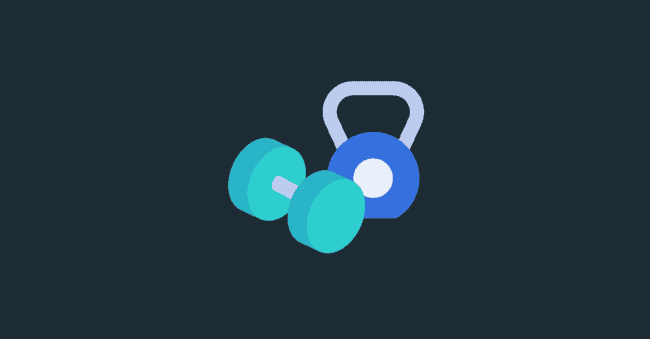
How to Start a Fitness Blog in 7 Steps
- Define Your Fitness Blogging Goals
- Choose a Fitness Niche
- Pick & Register a Blog Domain Name
- Setup WordPress
- Write & Publish Blog Posts
- Promote Your Fitness Blog
- Monetize & Make Money
1. Define Your Fitness Blogging Goals
The first step in starting a fitness blog is to define your goals. What exactly do you want to achieve with your blog?
Are you looking to simply share your love of fitness with the world?
Or are you hoping to use your blog as a platform to build a business around?
Maybe you have something else entirely in mind.
Whatever your goals may be, it is important to have a clear idea of what you want to achieve before moving forward. Doing so will help you focus your efforts and make better decisions down the road.
What is a Fitness Blog?
A fitness blog is a website where you share your knowledge and passion for all things related to fitness. This can include topics such as workout routines, healthy recipes, advice on staying motivated, and anything else that would be of interest to someone looking to improve their health and well-being.
Why Start a Fitness Blog?
A fitness blog can be a great way to connect with like-minded people and help others on their journey to a healthier lifestyle.
It can also be a fun and creative outlet to share your own personal experiences with exercise and nutrition.
There are many reasons why someone might want to start a fitness blog. The benefits of starting a fitness blog include:
- Helping others improve their health and wellbeing
- Connecting with like-minded people
- Sharing your own personal experiences
- Making money (if you choose to monetize your blog)
How much money can you make from Fitness blogging?
A fitness blog with 100 posts that gets on average 1000 page views per month for every post will make around $2815 per month from ads. Income will be higher if there are more blog posts or if the blog is also monetized with affiliate marketing and digital products. The keto fitness blog Fit Mom Journey made $10,124 in a single month.
2. Choose a Fitness Niche
Once you have defined your goals, the next step is to choose a niche for your fitness blog. A niche is simply a specific topic that you will be writing about on your blog.
Why choose a niche?
If you try to appeal to everyone then you will end up appealing to no one.
Choosing a niche helps you focus your content and market your blog more effectively. It also makes it easier to build an audience of loyal readers who are interested in what you have to say.
If you don’t choose a niche and blog about everything then, It will be harder to stand out from the crowd and you will have a harder time growing your blog.
Avoid YMYL Niches
YMYL stands for Your Money or Your Life. Robbers say this to their victims when they are trying to loot them. For bloggers, YMYL means niches and topics that directly affect a person’s health or finances.
If you wanted to find some information that affected your health, will you want to read an article written by a trusted doctor or some random health guru on the internet that could be fake information? Google wants you to see articles from trusted sources so that you don’t read misinformation that will affect your health.
Your Money or Your Life (YMYL) pages can have an impact on your current or future well being (physical, financial, safety, etc.).
YMYL pages should come from reputable websites and the content should be created with a high level of expertise and authority.
So Google has raised the bar for niches that affects a person’s health & finances. Blogs and websites need a lot of authority and credibility to compete in this space.
You should have the right professional credentials like having a medical or nutrition degree. You should have a photo of your face and show your credentials on the about page and the author bio under each blog post.
Articles need to be evidence-based information and not mere opinions. Source and medical journals need to be cited and referenced in the articles.
Also, YMYL niches are often audited by human evaluators and only if they pass the criteria do they rank high on Google.
You should avoid YMYL niches if you want to make money from your blog. These niches are extremely hard to compete in.
A good way to find out if your niche is YMYL is to do a Google search and see if only sites like WebMd, Health Line, and Mayo Clinic come up on the first page. If these are the only sites that appear, then it is a YMYL niche and you should try to avoid choosing that niche altogether.
If you see a mix of these high authority websites along with normal websites then you can still consider that niche.
For example, competing for Keto Diet related information is extremely difficult because it is YMYL. So any article that you write that has medical information simply won’t rank. However, if you go after Keto Diet Recipes, you will find it a lot easier to compete. The trick is to drill down and choose a sub-niche.
If you are really passionate about the topic and want to build a blog around it, then you can still choose a YMYL niche but it will be a lot of hard work followed by extremely slow growth.
Finding Your Ideal Niche
There are many niches in health and fitness. But the best niches are the ones you are passionate about.
If you are passionate about a niche then you will be able to write better content and connect with your audience on a deeper level. Look at your passion, skills, and experience. Your ideal niche is the intersection of all three.

Just make sure your niche is not entirely YMYL so that you don’t struggle to get search traffic. If it is YMYL can you choose a sub-niche so that it doesn’t become YMYL (Keto Diet to Keto Diet Recipes)?
Here are fitness niches in the fitness space that you can blog about:
- Vegetarians/Vegan
- Running
- Hiking
- Swimming
- Paleo Diet
- Keto Diet
- Recipes for Specific Types of Diets
- Different Types of Yoga
- High Intensity Interval Training
- Cardio
- Home Gyms/
- Crossfit
- Beginners Workouts
- Fitness for Older Adults
- Blog for Personal Trainers
- Guide for Gym Owners
- Meal Plans
- Smoothies
- Jump Ropes
- Calisthenics & Body Weight Workouts
- Weight Loss for Target Group (Example: Seniors, Pregnant Women).
Irrespective of the niche you choose, you can also choose to focus on a specific audience such as women, men, seniors, people with disabilities etc.
Examples of Fitness Blogs
Sometimes looking at other fitness blogs will help inspire ideas of your own. Here are 5 of the most popular fitness blogs:
1. NerdFitness
This blog focuses on workouts, diet, and mindset. They monetize their blog through their paid course. The blog is themed in such a way that it appeals to those who love to gamify their fitness journey.
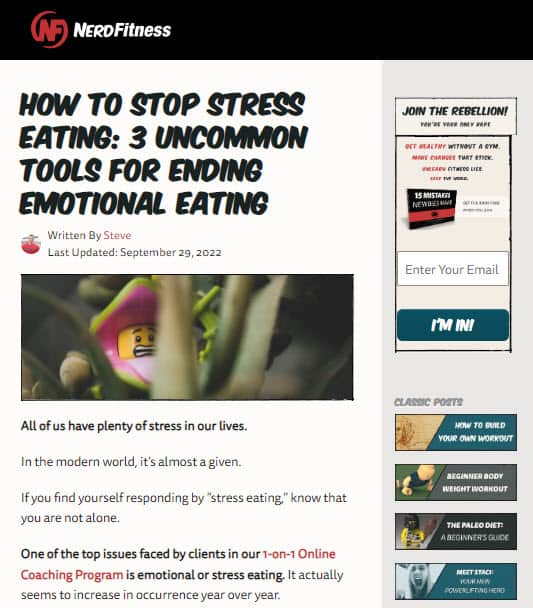
2. The SITS Girls
This blog is started by 2 sisters and it focuses on helping women of all shapes and sizes get fit. The blog has a very supportive community and they also offer paid courses. They make money through affiliate marketing, ads, sponsored posts, and their own products.

3. Fitness Blender
This blog offers free workout videos that you can do at home with no equipment. They have a huge range of workouts for various fitness levels. They also offer nutrition advice and workout programs that you can buy.
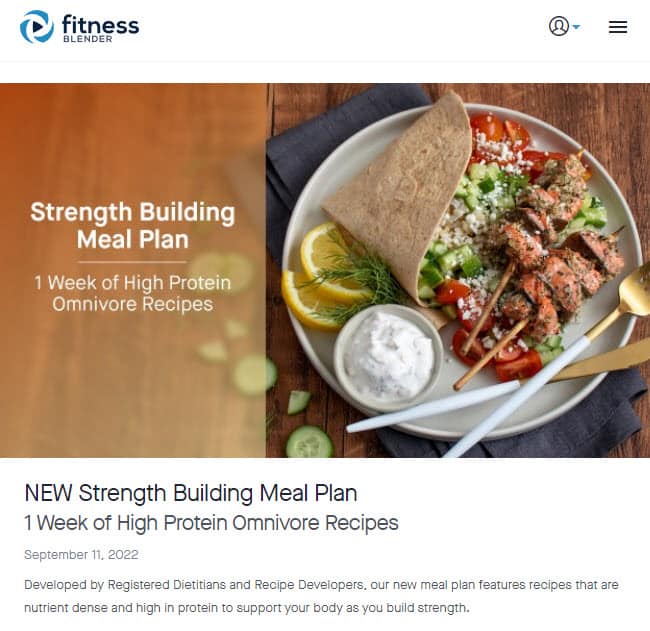
4. The Lean Green Bean
This blog is all about making healthy living easier. The blog has recipes, tips, reviews, and roundups to help people live healthier lives. The blogger also has a podcast that she uses to monetize her blog.

5. Mind Body Green
This is one of the biggest wellness sites on the internet. They write about pretty much everything related to health and fitness. They have a huge team of writers and they also offer online courses. They make money through ads, sponsored posts, and their own products.

3. Pick & Register a Blog Domain Name
Once you have chosen your niche, it is time to brainstorm a few names for your fitness blog.
We recommend you keep your fitness blog name to two words (Example: Nerd Fitness). One of the two words should be a keyword from your niche. The other word can be something that makes your website brandable. For example, our blog teaches people how to make passive income, so we have named it Passive Book.
Here are some of the words that you can mix and match into your blog name:
- Fitness
- Body
- Warrior
- Mind
- Shape
- Workout
- Health
- Nutrition
- Diet
- Exercise
- Active
- Training
- Life
- Shredded
Use a Business Name Generator to brainstorm the name of your blog.
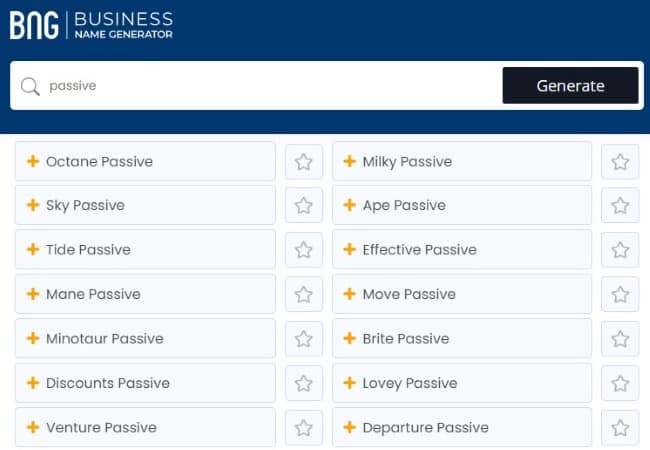
You can also use your own name for your blog. But if you ever plan to sell your website in the future, it is much more difficult to transfer your brand to the buyer when it is your name.
Check Domain Name Availability
After you have brainstormed a few names for your fitness blog, you should check if the .com domain name is available.
Your domain name is your blog’s address on the internet. It’s what people will type in a browser like Chrome to find your blog.
You must check if both the .com domain name and the social media handles are available. You can use Namechk to check the availability of both your domain name and social media handles.
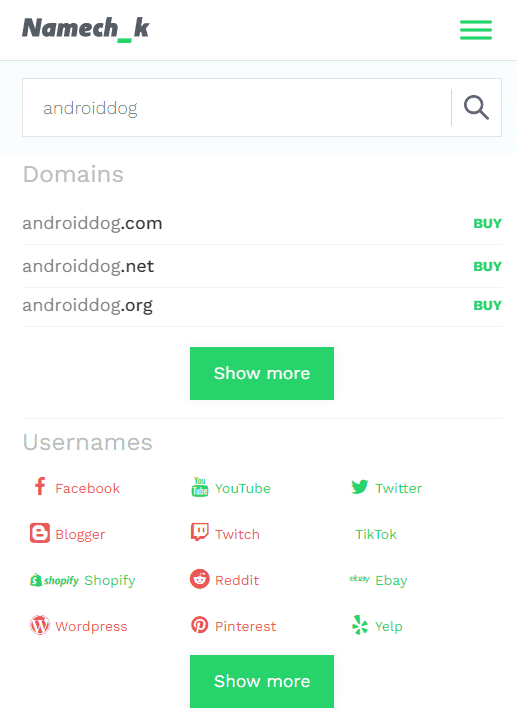
Here are a few things to keep in mind when selecting a domain name:
- Choose a .com domain name. 86% of the internet uses .com, so your visitors are likely to try visiting your blog by typing .com. Avoid other extensions like .net or .org.
- Don’t include hyphens and numbers.
- Do not use words with multiple spellings (for example colour vs color).
- Shorter domain names are better. Try to keep it under 12 characters.
- Spelling & Pronunciation should be easy and intuitive.
- It should be easy to remember.
- Avoid words that can be misread together. For example, therapistjohn.com can be read as Therapist John or The Rapist John.
- Make sure it’s not trademarked or copyrighted by someone else. The AI writing software Jarvis.ai had to rebrand to Jasper.ai because Marvel sued them for the Iron Man reference. Lawsuits will happen once your blog is established.

Register a Domain Name
Once you decide your domain name it is time to register it.
You should register your domain with NameCheap because you will get domain privacy for free. Other providers charge $12 per year for domain privacy. Without domain privacy, your name, home & email address will be accessible to the public.
Step 1: Go to NameCheap. Enter your domain name with the .com extension.

Step 2: Select the .com extension and click the Add to Cart button.
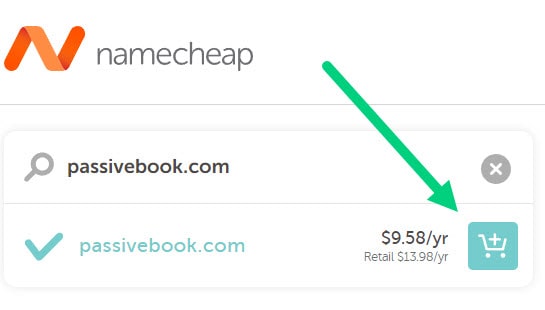
Step 3: After adding the domain to the cart, click on the Checkout button.
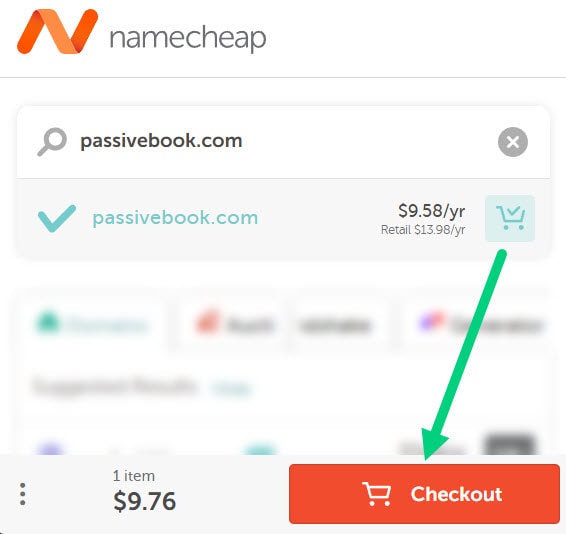
Step 4: Enable Domain Privacy that comes for free along with auto-renew. You don’t need any other paid addon.
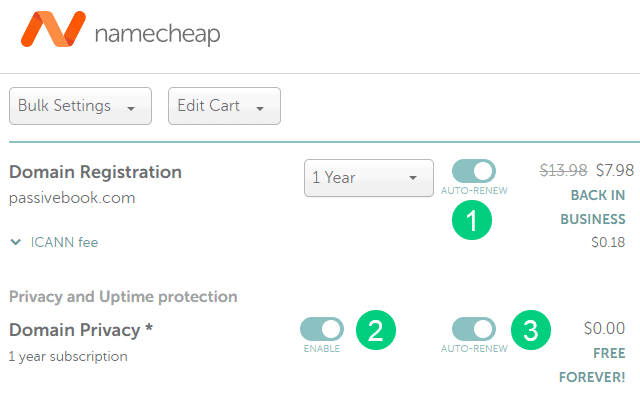
Step 5: Click on Confirm Order. Pay to complete your purchase.
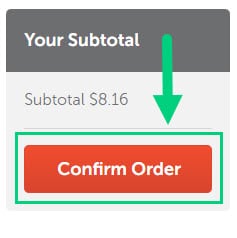
Step 6: Log in to Namecheap and click on Domain List ❶ in the left sidebar and then click Manage ❷ next to the domain you just purchased.
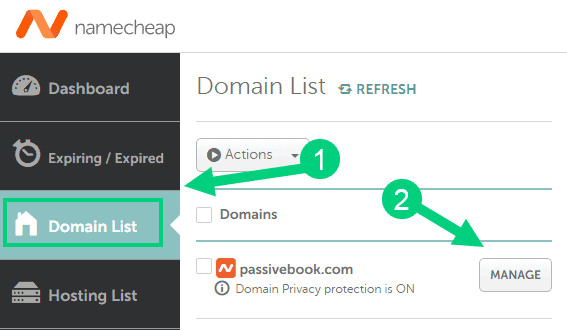
Step 7: Under the Nameservers section, select “Custom DNS” from the dropdown ❶. Then enter the following two nameservers ❷ ns1.bluehost.com and ns2.bluehost.com as shown in the image. Then click the green tick ❸ to save. If you use a hosting provider other than Bluehost, enter their nameserver values in this step instead.
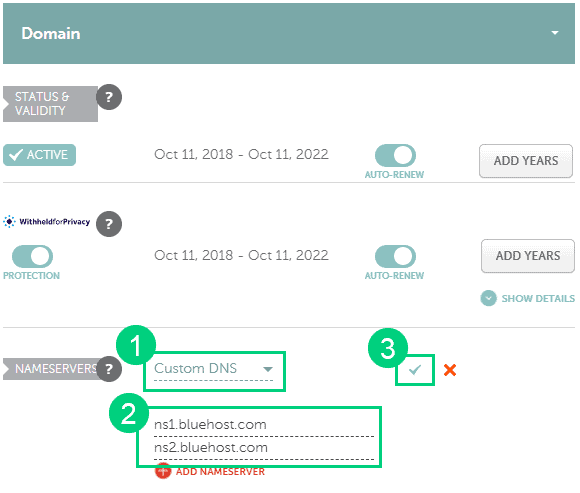
Can I get a free domain name?
Your web hosting provider might give you a free domain name for one year but they charge $12 for domain privacy which is free in Namecheap. From the second year, you will pay for both the domain and privacy which will cost you more than $20+. So it is cheaper to just register your domain with Namecheap from the beginning. Also using different companies for web hosting and domain registration will allow you to easily switch your blog host later without transferring domains.
Can I change the name of my blog later?
You will lose your search engine rankings if you change your blog’s name once it gets links from other websites. It will take as long as a year or more for you to regain the lost traffic. It is possible to mitigate problems by having proper redirects. But you will have to renew both your old and new domains every year. So try to avoid changing your blog’s name once it is established.
4. Setup WordPress
The next step is to get your blog up and running in WordPress. WordPress is the most popular blogging platform on the internet. It is very easy to use and it has a ton of features and plugins to make your blog look great. And the best part is, it is free.
Why Choose WordPress.org?
There are many blogging platforms but the self-hosted wordpress.org powers 70% of blogs on the internet. 42% of all websites on the internet use WordPress.
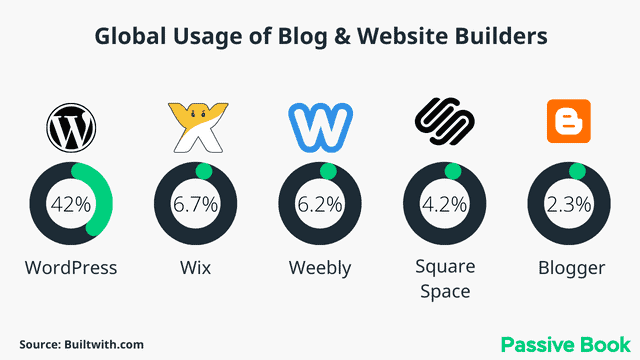
Here are some of the reasons to use WordPress.org:
- It is free to use. You just need to pay for hosting your blog and domain name (which we will show you how to do in a second).
- You can make your blog look however you want it to with themes and plugins.
- It is very easy to use. You don’t need to know how to code.
- It is very secure. WordPress is constantly updated with the latest security patches.
- You can easily add eCommerce functionality and start selling products on your blog with WordPress.
- You own your data. When you use other blogging platforms like Medium or Tumblr, you don’t own your data. But with WordPress, you own your data and can move it to any other host whenever you want.
WordPress.org vs WordPress.com
Do not confuse WordPress.org with WordPress.com. WordPress.com is a blogging platform but it has many limitations. For example, you can’t install plugins and themes on your blog and you don’t own your data.
WordPress.org is the self-hosted version of WordPress where you can install plugins and themes, and have full control over your blog. This is what we recommend you use.
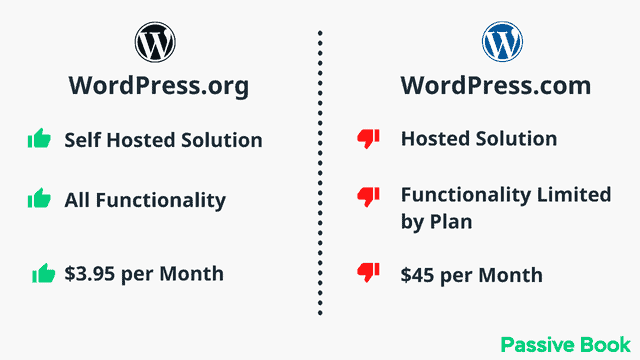
Why Avoid Free Blogging Platforms
Free blogging platforms like Blogger.com and WordPress.com might be tempting to use because they are free. But we recommend you avoid them for the following reasons:
- Your website won’t rank in the search engines.
- You have very limited customization options and you can’t install plugins.
- You don’t own your data. The platform can delete your blog anytime without any notice. For example, many blogger blogs are deleted by the platform regularly and all they see is the following screen.

How much does it cost to start a Fitness blog?
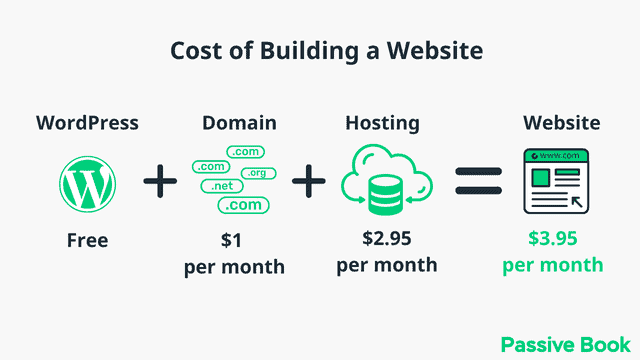
It will cost you $2.95 per month to host your WordPress fitness blog in Bluehost. A domain will cost you $12/year. So that is a total of $4.2 per month, which is less than the price of Netflix for all the unlimited features that a self-hosted WordPress blog has to offer.
What to do if you already have a free blog?
If you have a free blog, you can easily migrate it to WordPress using a free import plugin after you set it up.
Install WordPress in Hosting
To use WordPress.org, you need to first buy hosting for your blog and then install WordPress on it. We will show you how to do both of these things in the next few steps.
Hosting is a service that stores your blog’s files on a remote server. This way, you when someone types your domain name in a browser, your blog loads in their browser.
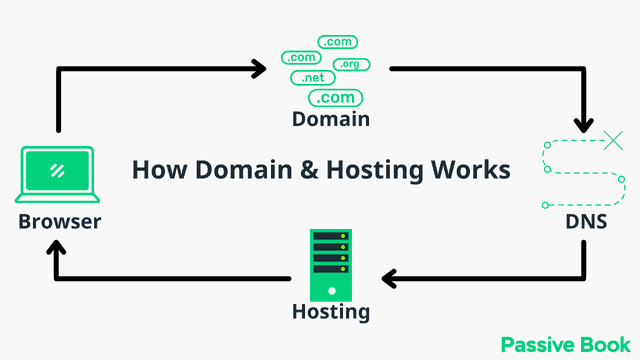
For this guide, we will use BlueHost as our web host. It is a cheap hosting that is extremely easy for beginners to set up. If you use any other web host, the steps will be the same but the user interface may be slightly different.
1. Go to BlueHost using this link to get a special discount. Select WordPress > WordPress Hosting from the top menu.
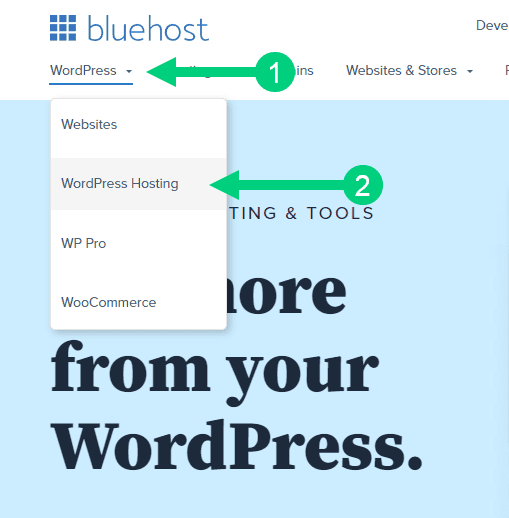
2. Click on the button you see on this page and you will be taken to the pricing section.
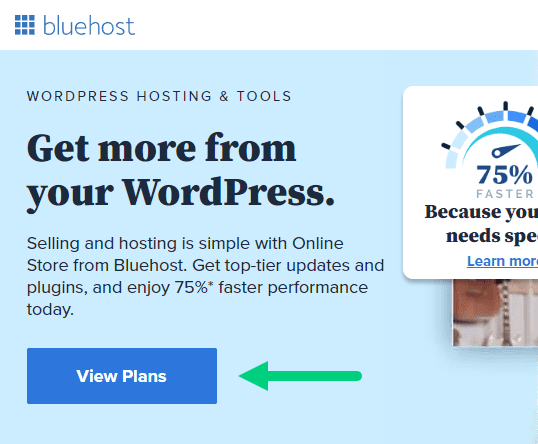
3. Select the Basic Plan. You can upgrade to a different hosting plan as you grow.

4. If you already have a domain name that you purchased with Namecheap you can put that in the “Use a domain you own” ❶ section. If you don’t have a domain name yet, choose the “Create a New Domain” ❷ to purchase a new domain.
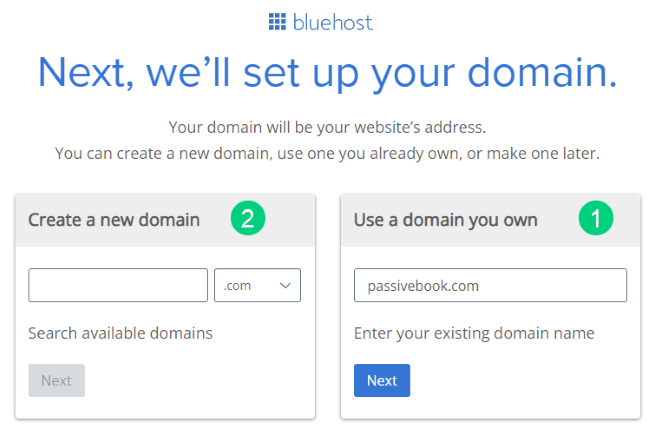
5. In the next screen, enter your information. Uncheck all package extras. If you purchase your domain through Bluehost instead of Namecheap, you may want to enable Domain Privacy. You won’t see the Domain Privacy option if you bought your domain through Namecheap. Namecheap will give you this Domain Privacy for free.
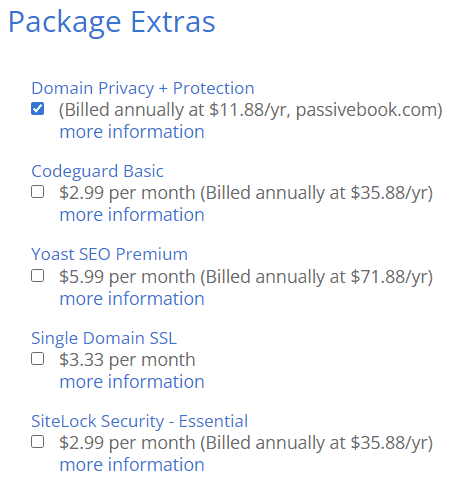
6. Once you have successfully paid, you will be prompted to set a password. Click on the “Create your Password” button.
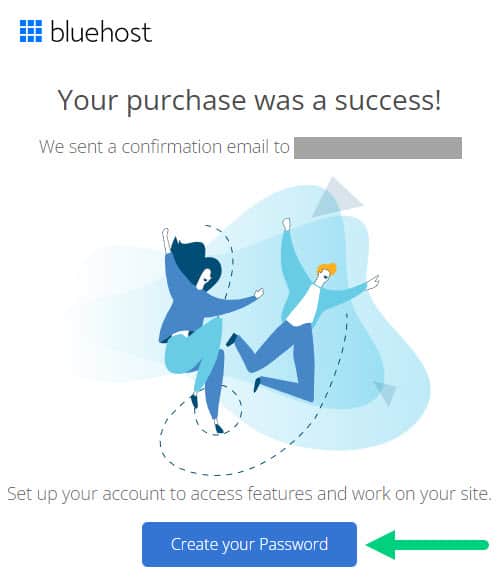
7. Enter your password and create your account. If you lose this password, you can reset it.
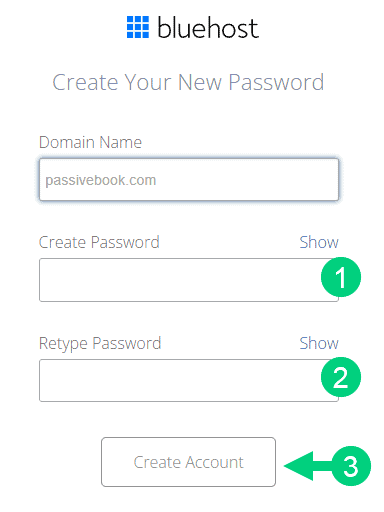
8. After you set your password, log in to Bluehost.
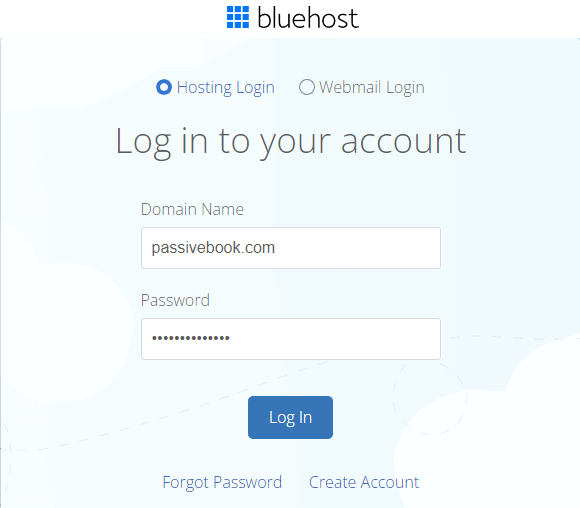
9. Click on the Create your website button on the following screen. This will start a Bluehost Wizard, just click Skip this step wherever possible.

10. On the following page, click “No help needed” or “Skip this step”. We don’t want Bluehost to limit our customization options.
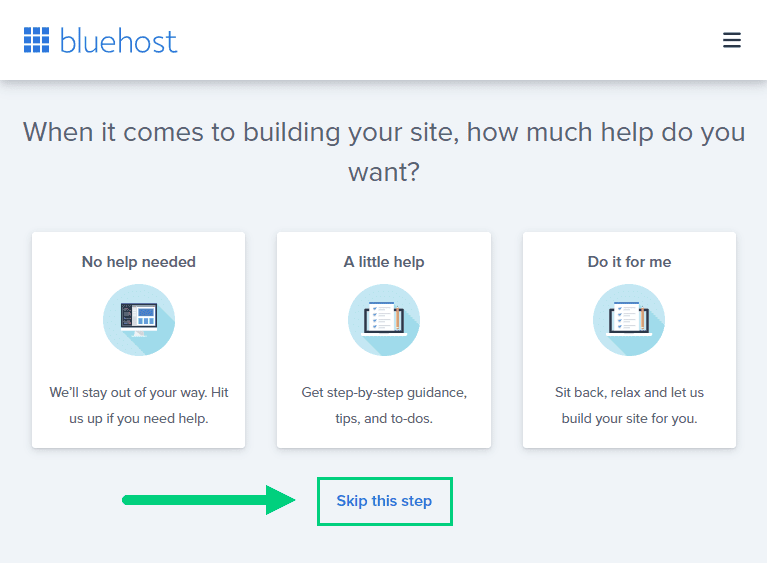
11. On the next page, you will be asked about the purpose of your website. You can choose from any of the available options.
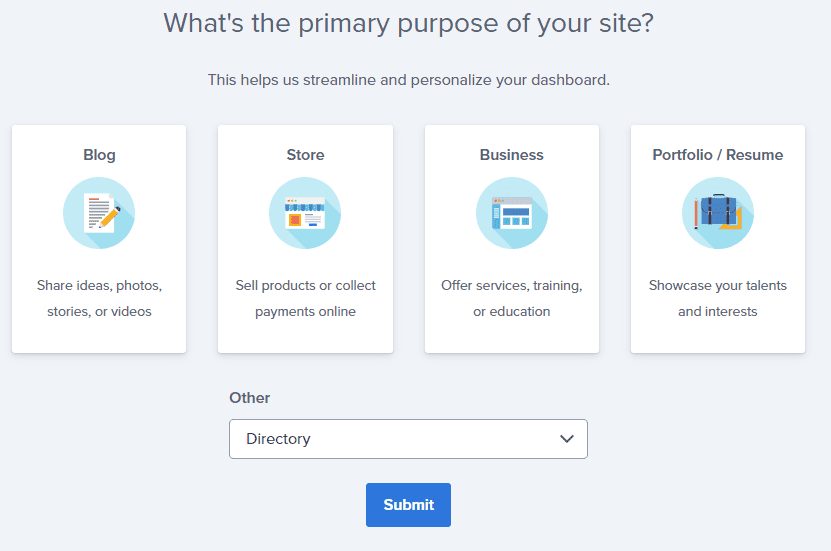
12. On the next page, click Skip this step.

13. On the following page, enter the blog’s name and tagline. You can change this later so feel free to click “Skip this step” or enter something as a placeholder and click Continue.
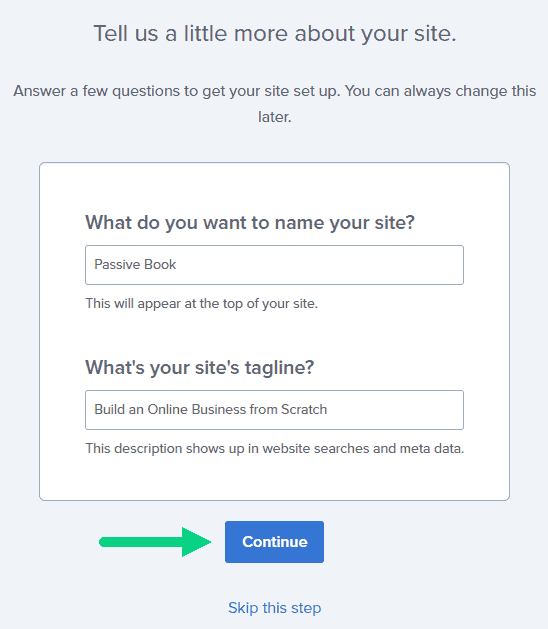
14. Finally you will be asked how you want to build your website. Choose “Limitless customization” to have all the options.

15. You can see your blog by going to yourdomain.com. Go to the Bluehost dashboard and click on the My Sites tab ❶ in the left sidebar and click on the “Manage site” button ❷.
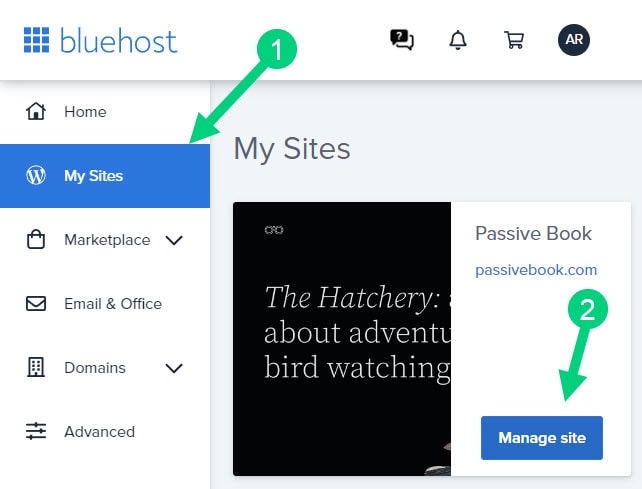
16. Your WordPress site has separate login credentials different from the ones you use to log into Bluehost. You can use this to log in to the WordPress dashboard directly without logging into Bluehost. To get this:
❶ Click on Users on top.
❷ You will be able to see your username and email that you can use to log in to WordPress.
❸ If you click on the three dots you will see the option to Reset your password. ❹
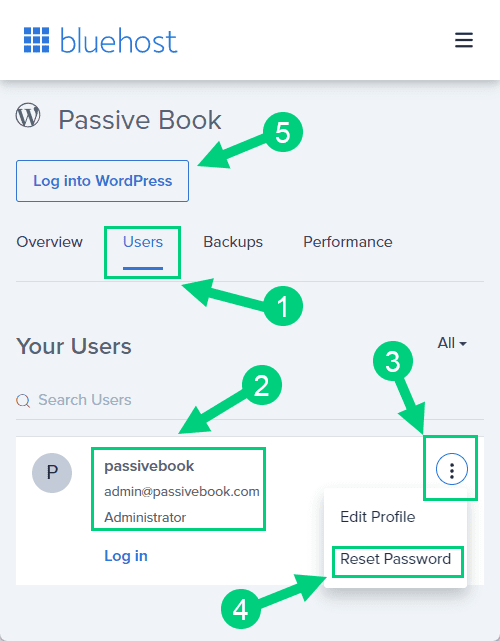
You can log into WordPress from the Bluehost dashboard by clicking the Log in to WordPress button ❺. But it is not recommended you rely on this as your primary login method because you will get locked out of your site if you ever change hosting providers.
17. You will be taken to the WordPress dashboard where you can reset your password ❶. If you don’t like the username Bluehost created for you, you can Add a New User ❷.

18. If you are adding a new user make sure you specify the user role as Administrator ❶. You can log in as the new user and safely delete the default user created by Bluehost.

Congratulations! You have successfully set up WordPress.
Configure WordPress
Now that you have the basic version of WordPress installed, it is time to customize it to make it look and feel the way you want.
Login to WordPress Dashboard
Visit yourdomain.com/wp-admin to access the WordPress dashboard.
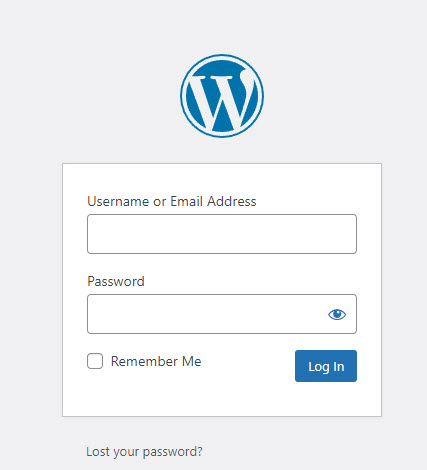
The WordPress Dashboard is the area where you can manage your website. You can edit your website’s settings, add new posts and pages, change your theme, and more from the WordPress Dashboard.
Use the Email and Password you provided during installation to log in to your WordPress dashboard. If you don’t have a password, use the “Lost your password?” to generate a new password.
Install WP Themes
A WordPress Theme is a collection of files that controls the look and feel of your WordPress site. You can change your theme at any time and your website will look different.
There are thousands of free and premium WordPress themes available. You can find free themes on the WordPress.org Theme Directory or use a paid theme as we recommend.
Your new WordPress blog will be installed with a default blog theme that doesn’t look very great.
To install a new WordPress Theme:
Go to Appearance > Themes > Add New in your WordPress dashboard.
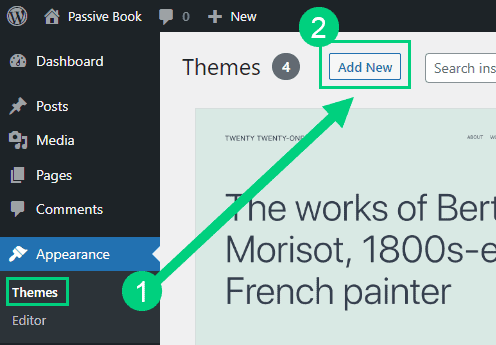
Use the search to find a theme that you like ❶. Before you install the theme, you can see a demo of the theme and learn about its features from the preview screen ❷. If you like the theme, you can install it by clicking the install button ❸. You can also upload a theme from a file on your computer ❹.

Once installed, click the Activate button to enable the theme.
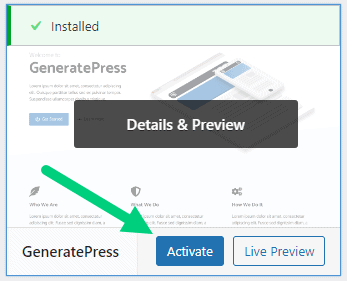
Although you can use a free theme (there are thousands of free themes available), we recommend using a premium theme.
Premium themes not only reduce your website’s load time but also help you customize your website to your heart’s desire.
Here are the premium themes we recommend:
There are also several themes custom-made for fitness blogs. These themes tend to be bloated with poor code which will slow down the performance of your website. We suggest getting one of our recommended themes for a fast website with unlimited customization possibilities.
Install WP Plugins
A WordPress Plugin is a software that adds additional features to WordPress. You can find thousands of free and premium WordPress plugins on the WordPress.org Plugin Directory.
Too many wordpress plugins can slow down your blog site. So before you install new plugins, it will be worth clearing out any existing plugins that your hosting provider installed by default.
Plugins first need to be deactivated before they can be deleted.
❶ Go to WP Admin > Plugins > Installed Plugins
❷ Click on the checkbox to select all plugins.
❸ Select Deactivate from the drop-down.
❹ Click Apply.
❺ Repeat the above steps but select “Delete” instead of “Deactivate” from the dropdown in ❸ to delete all the deactivated plugins.
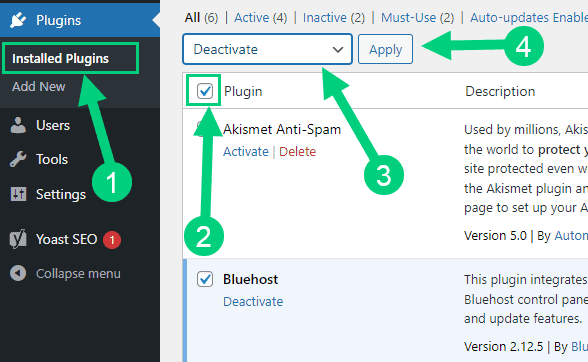
To install new plugins go to the WP Admin > Plugins > Add New.

On the plugins page:
❶ Search for the plugin you want in the search bar
❷ Click Install Now. Once you install the plugin, you must also activate the plugin for it to be enabled.
❸ If you are installing a paid plugin you can upload the plugin instead.
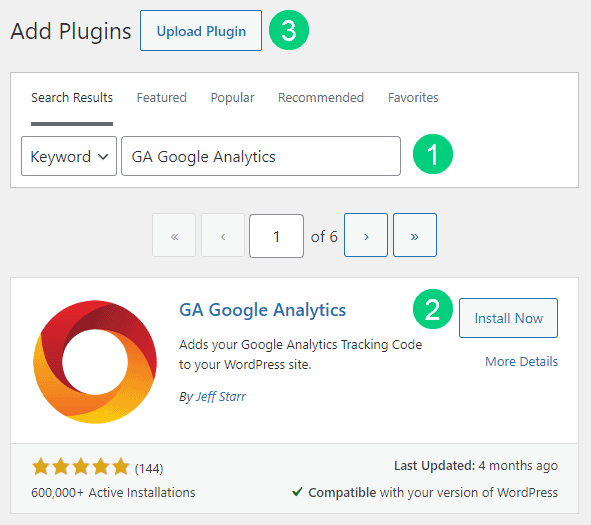
There are many different plugins that you can install, but here are the ones which we recommend:
Backup Plugin
A WordPress Backup Plugin helps you create backups of your WordPress website. This way, if something goes wrong with your website, you can restore it to its previous state.
Recommended Plugin: WPVivid (paid) or UpdraftPlus (free).
SEO Plugin
A WordPress SEO Plugin helps you improve the search engine ranking of your website. The plugin optimizes your website for better search engine visibility by adding features to your blog.
Recommended Plugin: RankMath (paid).
Google Analytics Plugin
A WordPress Analytics Plugin helps you integrate Google Analytics which is free software that helps you track and analyze the traffic to your website. It does this by providing you with reports on website visitors, page views, and other important statistics.
Recommended Plugin: RankMath (paid) or GA Google Analytics (free).
Cache Plugin
A WordPress Cache Plugin helps you speed up the loading time of your website. It does this by caching your website’s pages and posts in a temporary storage area so that they don’t have to be regenerated every time someone visits your website. This speeds up the loading time of your website,
Recommended Plugin: WP Rocket (paid).
Page Builder Plugin
A WordPress Page Builder Plugin helps you create custom pages and posts for your website. It has a visual interface, where you can drag and drop different elements onto your page or post. This makes it easy for you to create custom pages and posts without having to know how to code.
Recommended Plugin: Thrive Architect (paid).
Security Plugin
A WordPress Security Plugin helps you protect your WordPress website from hackers and malware. The plugin adds security features to your website such as two-factor authentication, malware scanning, and firewalls.
Recommended Plugin: Wordfence (free).
Social Media Plugin
A WordPress Social Share Plugin is a software that helps your readers easily share your blog posts and pages on social media platforms such as Facebook, Twitter, and LinkedIn. It provides you with easy-to-use social media buttons which you can add to your blog posts and pages.
Recommended Plugin: Easy Social Share Buttons (paid).
Fitness Calculator Plugins
A WordPress Fitness Calculator Plugin helps you add a fitness calculator to your website. This allows your visitors to calculate their BMI, body fat percentage, and other important fitness metrics. There are many custom fitness calculators with formulas built in. But we recommend using a good form plugin where you can manually input formulas and create a calculator.
Recommended Plugin: Fluent Forms (paid).
Customize WordPress
Once you have installed your theme and plugins, it is time to customize the wordpress blog platform:
Change Colors, Fonts & Spacing
You can set the font, colors, and spacing by going to Appearance > Customize in your WordPress dashboard. Premium themes like GeneratePress allow you to customize every aspect of your blog.
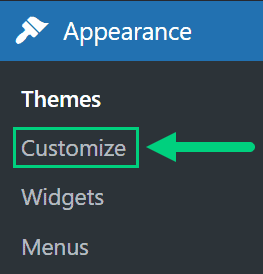
Check out our Blog Fonts & Typography guide to choose the right font and typography settings for your blog.
Add Your Logo
Get a logo designed for your blog from Fiverr. Then set the logo of your blog by going to Appearance > Customize in your WordPress dashboard. A logo is not required for a successful blog but it can definitely help appeal to your target audience.
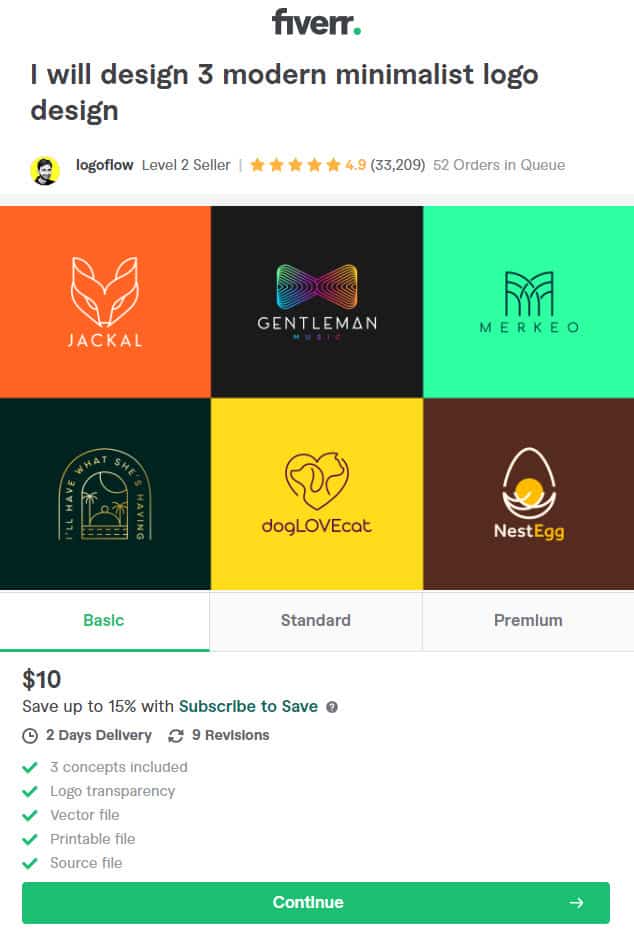
Change Favicon
Favicon is the image that appears in the browser tab and bookmarks. Set the Favicon from the Appearance > Customize section of the WordPress dashboard.

Create Menus
The header and the footer menu can be set from the Appearance > Menus in your WordPress blog dashboard.

You can nest menu items so that it appears as a dropdown menu ❶. You can use the menu as your primary or secondary navigation menu ❷. Don’t forget to save your menu ❸.
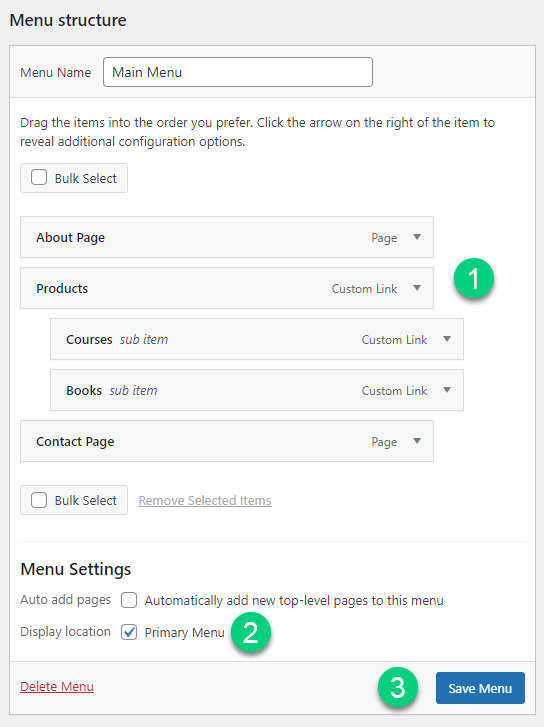
Create Widgets
If you have a sidebar, you can add widgets to it. Go to Appearance > Widgets in your WordPress admin dashboard.
Check out the list of the most useful Blog Widgets and how to add them to your blog.

Set Title & Tag Line
The next step is to change your General Settings. Go to Settings > General in the WordPress Admin area.
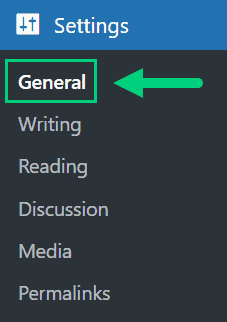
You can set your Site Title, Tagline, and Time Zone from this screen.
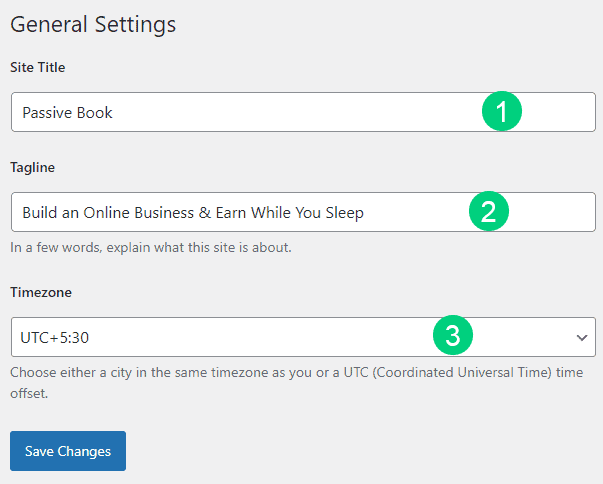
Set Permalinks
The ideal URL structure for SEO is yourdomain.com/sample-post. Set your permalink structure by going to Settings > Permalinks in your WordPress blog dashboard.

Select the “Post name” radio button and save changes.
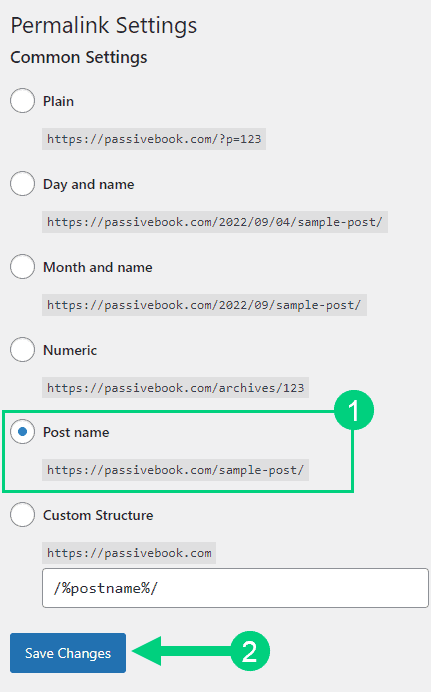
Enable Search Visibility
Chances are you want your blog to show up on Google so people can find you. Go to Settings > Reading in your WordPress dashboard.
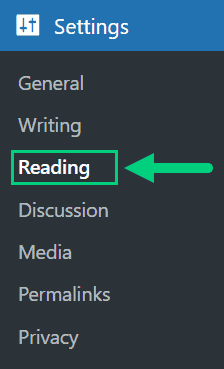
To get search engine traffic, ensure the checkbox “Disable search engines from indexing this site” is Unchecked. You can find this option in Settings > Reading. Most of the time this should be unchecked by default but if it is not, then uncheck it to ensure your site gets traffic from search engines.
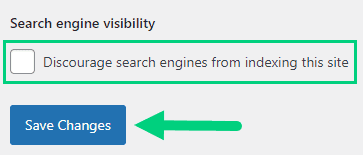
Adjust Comment Settings
Next, you will want to change the Discussion Setting (aka Comments). Go to Settings > Discussion in your WordPress admin area.
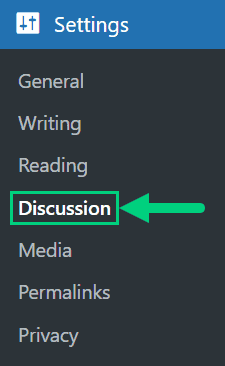
❶ You may want to enable or disable comments on this page. You can also disable pingbacks and enable comment moderation.
❷ You can also set comment approval settings.
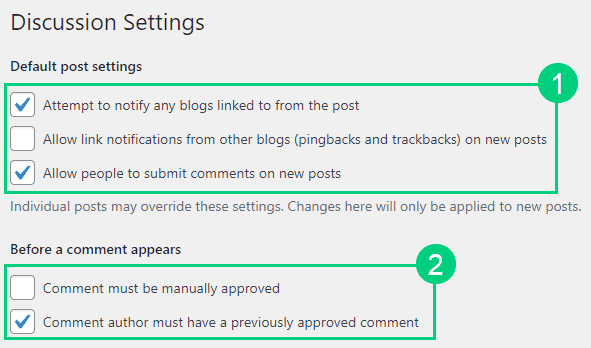
If you want to design your blog further, check out our dedicated guide on blog design which has all our best blog design recommendations.
Create Static Pages
There are a few essential pages that you need to create for your fitness blog before you can start blogging.
Use pages in WordPress to add static content. Go to WP Dashboard > Pages > Add New.
- Write the headline of your content.
- Populate the body content
- Click the publish button.

You may want to create the following pages:
Home Page
A home page is the main page of your website. It is the first page that your visitors see when they visit your website. The home page usually contains a welcome message, a list of your most recent blog posts, and a few other important pages such as your contact information.
You can create a professional home page for your fitness blog using a page builder like Thrive Architect.
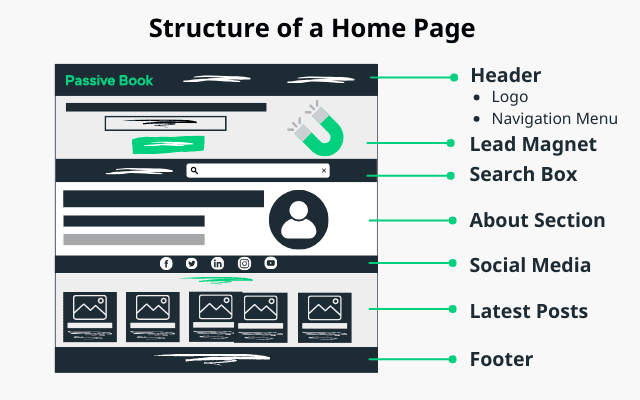
About Page
An about page is a page that tells your visitors who you are and what your website is all about. It is one of the most important pages on your website, as it helps you connect with your visitors and build trust.
Your about page should include:
- A brief description of who you are
- What your website is about
- Your mission statement
- Your contact information

Contact Page
A contact page is a page that allows your visitors to get in touch with you. It should include your contact information such as your email address, phone number, and social media profiles.
Use contact form plugins like Fluent Forms to create the form on your contact page.
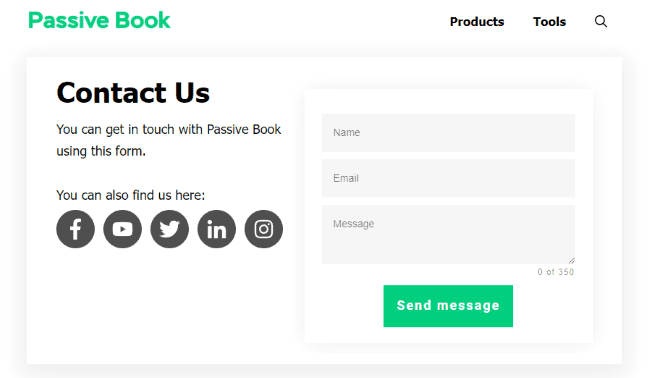
Privacy Policy
A privacy policy page is a page that tells your visitors how you collect, use, and store their personal information. It is required by law in some countries, and it is a good idea to have one even if it is not required in your country.
WordPress generates its own privacy policy for you. But you can also use a tool like Termly to generate your own privacy policy.

Terms of Service
A terms of service page is a page that tells your visitors the rules and guidelines for using your website. It is a good idea to have one even if it is not required in your country.
WordPress generates its own terms of service for you. But you can also use a tool like Termly to generate your own terms of service.
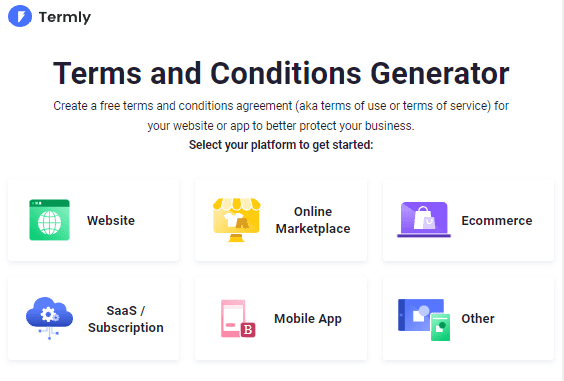
5. Write & Publish Blog Posts
Now that you have your fitness blog set up, it’s time to write and publish your first blog post.
1. Brainstorm Topics
You should brainstorm 100 topic ideas for your fitness blog. This will ensure that you always have content to write about in your fitness blog.
The goal is to find topics for your fitness blog that your audience is searching for in Google. The type of content you write on your fitness blog will depend on your specific niche. You can potentially cover the following topics on your fitness blog:
- Workout & Exercise Routines
- Meal Plans
- Recipes
- Fitness Tips
- Gym Equipment Reviews
There are a few ways to brainstorm specific content:
Look at Competitors
You should research your competitors to see what content they are writing about. This will give you an idea of the type of content that is popular in your niche and the type of content that your audience is interested in.
If you don’t know who your competitors are, simply google your keyword to find who is ranking for your keyword.
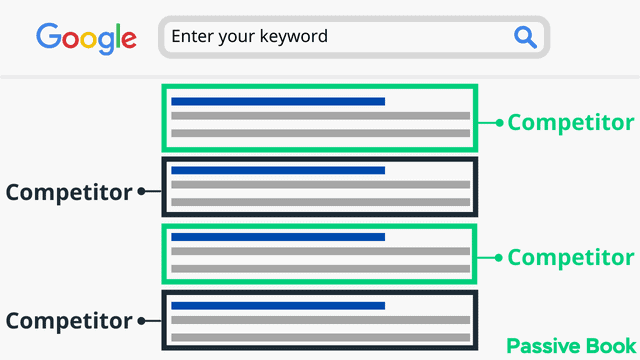
Do Keyword Research
You can also use keyword research tools to find a list of topics that you can write about. Plugin your keyword into a tool like Keywordtool.io to find similar keywords and topics you can write about.
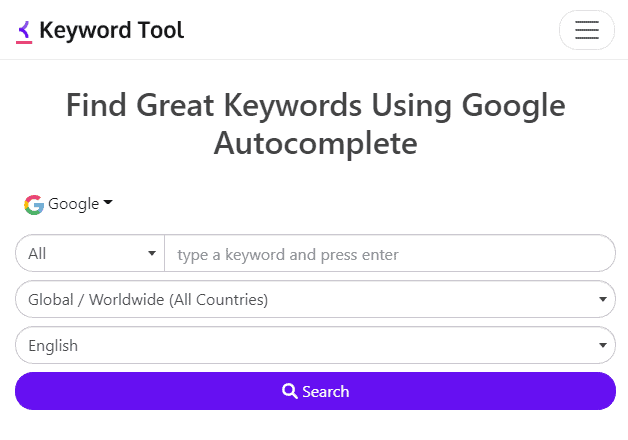
Community & Forums
You can also find popular content ideas by looking at relevant communities and forums. See what people are talking about and look for content ideas that you can write about.
You can find forums and communities by typing “keyword + forum” into Google.
Also, look at Facebook Groups and Reddit threads to mine topic ideas.
2. Create an Editorial Calendar
Once you have a list of topics, you should create an editorial calendar. This will help you stay organized and ensure that you are consistently publishing new content on your fitness blog.
Download Content Calendar Template

Steal our exclusive content calendar template. Have it delivered directly to your inbox:
An editorial calendar should include the following:
- The topic of each blog post
- The date the post will be published
- The author
- A brief description of the blog post
You can use a tool like Google Sheets or Trello to create an editorial calendar for your fitness blog.
3. Write a Blog Post
Now it’s time to write and publish your first blog post.
Workout Guides
These posts provide step-by-step instructions for specific exercises or full workout routines that readers can follow.
Examples of blog post titles might include “The Ultimate Guide to Barbell Squats” or “Full-Body Workout for Beginners.
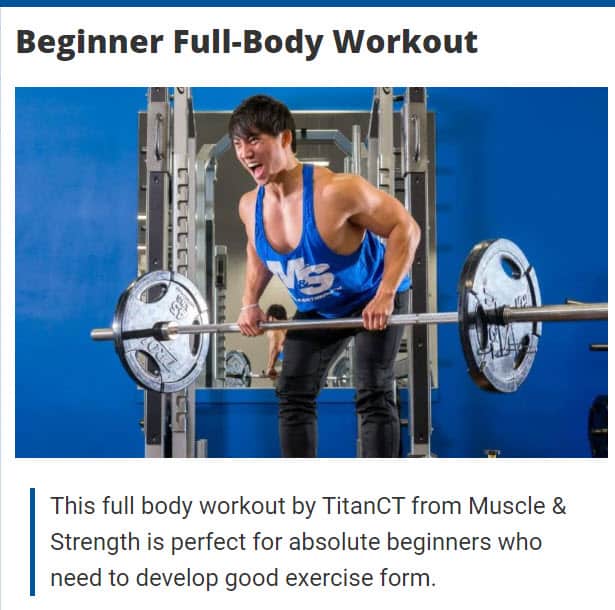
When writing workout guides, it’s important to make sure you explain each exercise clearly and include both text and visual instructions (such as photos or videos) to help readers understand the proper form and technique. It’s also good to consider adding some insights about the muscle groups targeted and the level of difficulty of the workout.
Fitness Challenges
These posts challenge readers to take on a certain workout or fitness goal and provide tips and encouragement to help them succeed.
Examples of blog post titles might include “30-Day Push-Up Challenge” or “The Ultimate Ab Challenge.

When writing fitness challenges, it’s important to set clear goals and provide a detailed plan for achieving them. Also, consider sharing your personal experience with the challenge, your progress, and your struggles, to inspire your readers.
Nutrition advice
These posts provide information on healthy eating and diet and include recipes for healthy meals and snacks.
Examples of blog post titles might include “The Best Foods for Building Muscle” or “10 Quick and Easy Healthy Snack Ideas.

When writing nutrition advice, it’s important to provide accurate and reliable information and to make sure you’re addressing your reader’s specific needs, dietary restrictions, and concerns.
Product Reviews
These posts review and recommend different types of fitness equipment, supplements, or other products that could be of interest to readers.
Examples of blog post titles might include “The Best Treadmills for Home Workouts” or “Our Top Picks for Protein Powders.
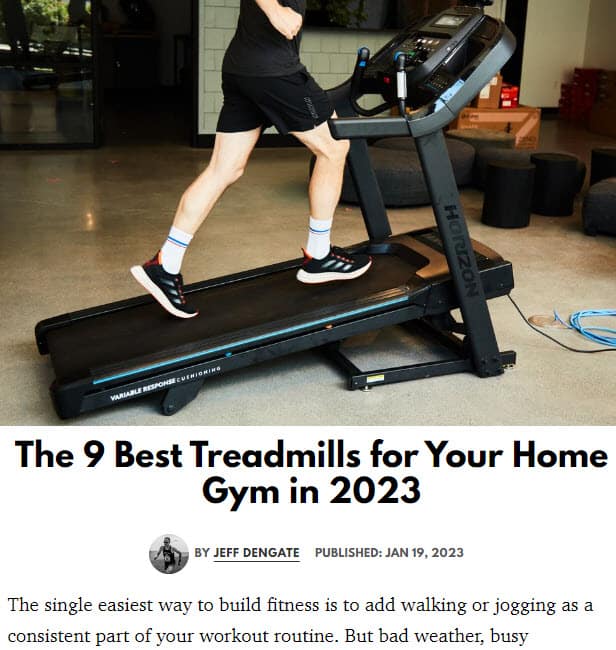
When writing product reviews, it’s important, to be honest and unbiased and to include both the pros and cons of the products you’re reviewing. Also, consider providing some examples of how you use the product and the results it brought you.
Motivational Posts
These posts share stories of people who have overcome obstacles or achieved their fitness goals, to inspire and motivate others.
Examples of blog post titles might include “From Zero to Hero: The Inspiring Transformation Story of John Doe” or “How One Woman Overcame Her Fear of Lifting Weights.

When writing motivational posts, it’s important to choose inspiring and relatable stories and to provide details about the person’s journey and the challenges they faced. Also, include tips and advice on how to overcome similar obstacles.
“How-to” post
These posts teach readers how to perform a particular exercise correctly with proper form, equipment, and technique.
Examples of blog post titles might include “The Correct Way to Do a Pull-Up” or “Mastering the Deadlift: Tips and Tricks.

When writing a “How-to” post, it’s important to explain the proper form and technique as clearly and detailed as possible, using images and videos to help readers understand. Also, consider listing the benefits and possible risks of the exercise.
Q & A
These posts answer the most frequently asked questions of your readers, to help them solve their doubts.
Examples of blog post titles might include “The Top 10 Questions About Losing Weight Answered” or “Your Most Common Questions About Stretching Answered.
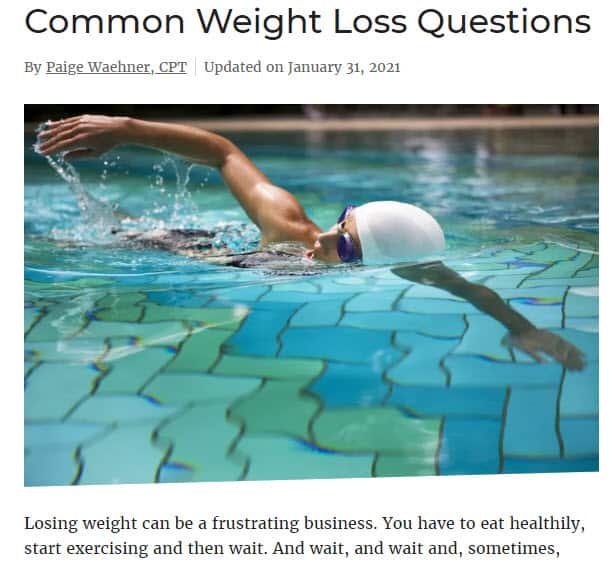
When writing Q&A posts, it’s important to research what your readers are asking and to provide clear and informative answers. Also, consider creating a sense of conversation, encouraging readers to keep asking questions, and engaging with your content.
News & Research
These posts keep your readers informed of the latest news and research in the fitness industry and how they affect the readers.
Examples of blog post titles might include “The Latest Research on High-Intensity Interval Training” or “The Pros and Cons of the Keto Diet, According to Science.

When writing news and research posts, it’s important to provide accurate and reliable information and to use credible sources. Also, consider including some thoughts and opinions on the matter, and how it relates to your readers and their goals.
Personal Experiences
These posts are your personal experiences with a particular diet, workout, or health concern.
Examples of blog post titles might include “My Journey with Intermittent Fasting” or “Why I Quit My Gym Membership.
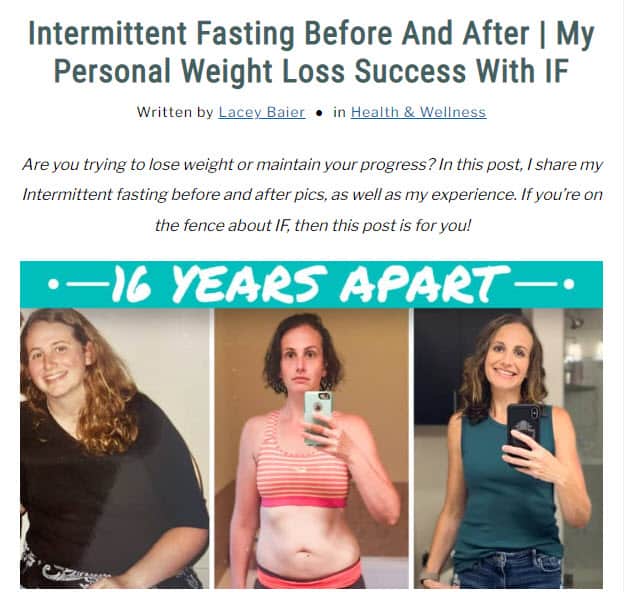
It’s important, to be honest and authentic and to share the details of your journey and what you learned from it. Also, consider highlighting some tips and advice that you think could be helpful for your readers, and how your experience could relate to them.
Write 5x Faster With AI
You can write your new blog post at 5x speed using the AI writing software Jasper. I was able to write over a hundred blog articles in 3 months using Jasper. This blog article you are reading right now was written with the help of Jasper. AI will not only help you write blog posts fast but also with higher quality.
Jasper can write plagiarism-free blog content, articles, social media content, emails, and ad copy. All you have to do is provide a few inputs on what you want and Jasper will do all the hard work of creating the blog content for you. No more writer’s block.
Check out the video below to see Jasper in action:
Try Jasper for free using the links on this page and get 10,000 bonus credits you can use to start writing your first articles.
Once you sign up for Jasper I recommend you spend some time going through the tutorial videos in the Jasper Bootcamp to truly unlock the power of this amazing software.
Check out our guide on How to Write a Blog Post Fast in 15 mins Without Losing Quality for more tips to write fast.
Outsource Writing
You can also outsource the writing of your blog posts. This is a good option if you don’t have the time or resources to write the blog post yourself.
There are a few ways to find writers for your blog:

4. Add Images
You should also add images and other forms of media to your blog posts. This will make your blog posts more visually appealing and easy to read.
You can find stock images to use on your blog from sites like:
Free Options: Pixabay, Pexels, Upsplash
Paid Options: Deposit Photos, Shutterstock, iStock, Getty Images, 123rf.
You can edit your images in Canva to make them your own. If you get Canva Pro, you can also access their library of free stock photos and won’t have to use another stock photography website.
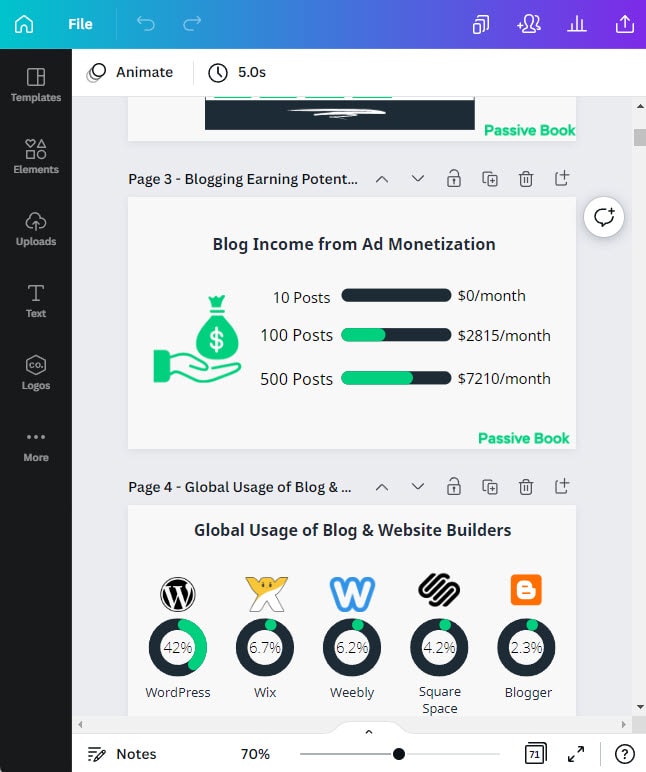
6. Promote Your Fitness Blog
A successful fitness blog will get traffic. Here are the most popular ways for a fitness blogger to get blog traffic:
Search Engine Optimization (SEO)
You should optimize each of your blog posts for SEO. This will help you rank higher in Google and get more traffic to your fitness blog.
Here are a few tips for optimizing your blog post:
- Use keyword-rich titles
- Use keywords throughout your blog post
- Optimize your images with keywords
- Add meta descriptions to each blog post
- Add alt text to each image
Many factors go into SEO, and it can be a bit confusing to figure out where to start. You can master the more advanced SEO tactics by checking out our SEO Resources.
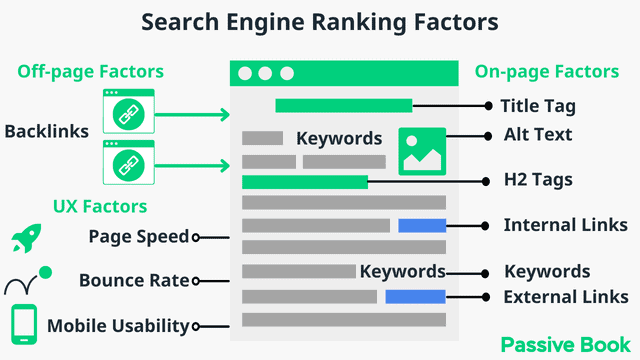
You can ensure you get the basics of SEO right, by completing the recommendations given by the RankMath plugin.
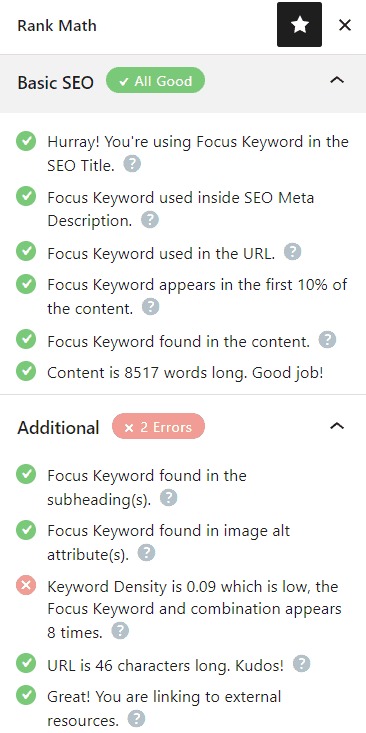
Email Marketing
You can also use email marketing to promote your fitness blog. You can collect emails from your website visitors using an email capture tool like Thrive Leads.
Once you have a list of email subscribers, you can send them updates whenever you publish a new blog post. You can also use email marketing to promote other content or products on your website.
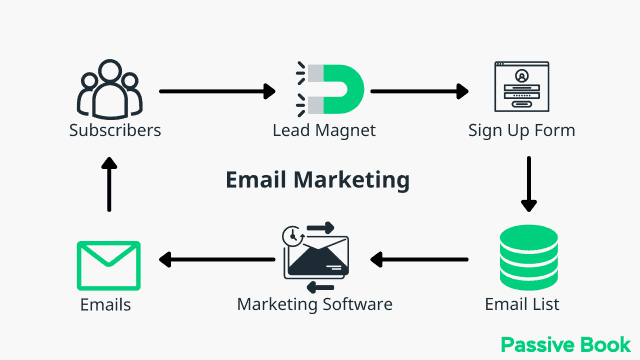
You can use the Thrive Leads plugin to build opt-in forms to collect email addresses. You can then connect the opt-in form to an email marketing service like Active Campaign to send out the emails.
Check out our Email Marketing resources to learn more.
Social Media Marketing
You should also promote your blog posts on social media. This will help you reach a wider audience and drive traffic to your website.
Share each of your blog posts on social media sites like Facebook, Twitter, Pinterest, Instagram, and LinkedIn.
Guest blogging
Guest blogging is also a great way to promote your blog. This involves writing a blog post for another website in your niche.
Not only will this help you get exposure for your fitness blog, but it will also help you build relationships with other fitness bloggers. You should want to write guest posts for popular blogs in your niche.
To find guest blogging opportunities, you can do a Google search for “keyword + guest post.” You can also contact other bloggers in your niche and ask if they’re interested in publishing a guest post from you.
You can include links back to your blog inside the article and promote your blog inside the author bio.

7. Monetize & Make Money
Once you have published a few posts and started getting traffic, you can start to think about monetizing your blog posts.
Advertising
You can advertise on your blog. This is a great way to make money from your blog without having to sell any products or services.
To start advertising on your blog, you can sign up for an ad network like Ezoic (they pay more than Google Adsense). When your blog starts getting more than 100,000 page views a month you can monetize with Adthrive.
| Ad Network | Earnings Per 1K Impressions (EPM) | Monthly Traffic Requirement |
|---|---|---|
| Ad Thrive | $13 | 100,000 |
| Ezoic | $3 | 10,000 |
| Media.net | $1 | – |
| Google Adsense | $1 | – |
Affiliate Marketing
You can also make money from your blog by promoting affiliate products. This involves promoting other people’s products or services on your blog and earning a commission for each sale that you generate.
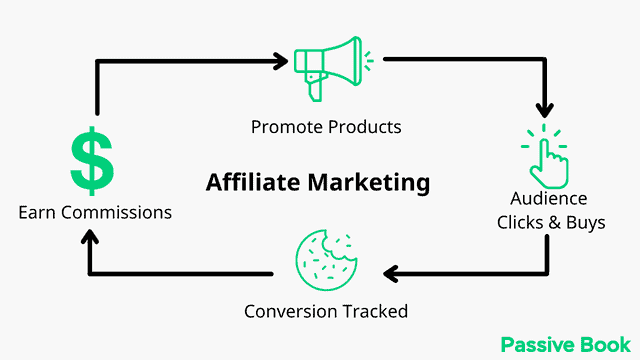
To find affiliate programs, you can search for “fitness affiliate program.” You can also repeat the search for “health affiliate program”
Digital Products
You can also make money from your blog by selling digital products. This could involve selling eBooks, courses, or other digital products that you create yourself.
You can also sell physical products on your blog. This could involve promoting and selling fitness equipment, health supplements, or other fitness-related products.
You can use Teachable if you want to sell video courses. Your students will have a dedicated course members area and a community system to ask questions and interact with each other. If you only want to sell eBooks, you can use SendOwl which lets you sell your digital products and eBooks for free.

Sell Services
If you have a service that you offer, you can also sell this on your blog. This could involve offering personal training services, nutrition coaching, or other fitness-related services.
Physical Products
You can also make money from your blog by selling physical products. This could involve promoting and selling fitness equipment, health supplements, or other fitness-related products.
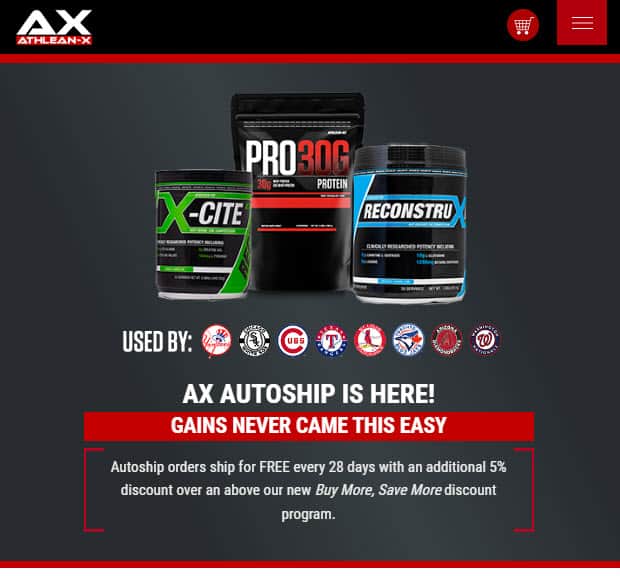
Sponsored Posts
You can also make money from your blog by writing sponsored posts. This involves getting paid to write a blog post that promotes a product or service.
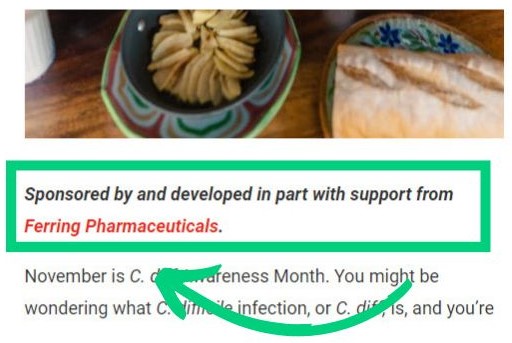
To find sponsored post opportunities, you can contact companies directly or use a service like IZEA.
FAQ
Here are a few frequently asked questions:
What do you write in a fitness blog?
When writing a fitness blog, you should aim to provide helpful and informative content that will help your readers achieve their fitness goals. You can write about topics such as exercise, nutrition, and motivation.
How long does it take to make money from a blog?
It can take anywhere from a few months to a few years to start making money from your blog. It depends on factors such as the niche you’re in, the amount of traffic you’re getting, and the monetization methods you’re using.
How can I make my fitness blog successful?
There are many things you can do to make your fitness blog successful. This includes writing high-quality content, promoting your blog on social media, and guest blogging. You can also join relevant Facebook groups and forums to network with other bloggers in your niche.
What Next?
If you have any questions as you set up your new blog, leave a comment below so we can help you out.
Starting a fitness blog is a great way to share your passion for health and fitness with the world. It can also be a great way to make money online. When you start a blog it can also become a fitness business.
Have you started your fitness blog yet? What type of fitness blog are you going to start? Let us know in the comments.
Share this post with your friends & followers:
